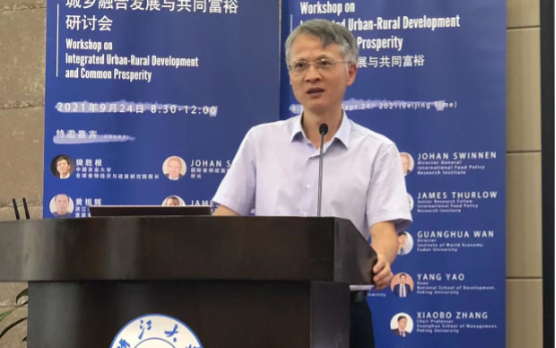China faces ongoing challenges integrating the economies of its rural and urban areas as it seeks to build on the dynamism of cities to benefit the country’s large population of rural residents—who continue to face widespread poverty and other problems.
A Sept. 24 workshop explored these issues in light of China’s “common prosperity” policies, COVID-19 impacts, and more. The event was jointly organized by the China Academy for Rural Development (CARD) and the School of Public Affairs (SPA) at Zhejiang University (ZU), with the support of the ZU-IFPRI Joint Center for International Development Studies as well as the ZU Food Systems and Policy Lab.
President Xi Jinping is now pursuing a policy of “common prosperity” aimed at narrowing the large gaps between the relatively small group of extremely wealthy and everyone else. The Chinese government has designated Zhejiang as a High-quality Development and Construction of Common Prosperity Demonstration Zone, making it an important test case for potential urban-rural policy reforms.
Rural areas have weathered the economic impacts of the COVID-19 pandemic better than urban areas, with smaller drops in income and consumption, IFPRI Senior Research Fellow James Thurlow said. This reduced the urban-rural income gap and social inequality to some extent, though a serious imbalance remains.
China’s census data shows a mere 30% of the population has a high school education, which shows how the country’s human capital continues to lag compared with other developing economies, noted Scott Rozelle, Professor at the Freeman Spogli Institute for International Studies of Stanford University. The rural-urban gap is a primary reason for this problem. For example, more than 60% of rural children are delayed in cognitive and social-emotional development, Rozelle said.
Empowering rural residents with equal access to quality education is crucial for realizing common prosperity, said Yang Yao, Dean of the National School of Development of Peking University. “From the philosophical perspective, neoliberal researchers believed in procedure equality,” he said, but equality of opportunity “is not enough for China, because rural residents lack income capability.” Rural areas lag in both educational attainment and educational mobility, he noted. He recommended that China do more to ensure equal access to education, such as extending the period of compulsory education.
How can urban-rural development be better integrated to help narrow this gap? One approach is to increase mobility between urban and rural areas. One way to do this is to strengthen social and economic linkages of villages and towns with intermediate-sized cities by removing institutional and policy barriers, said Shenggen Fan, Dean of the Academy of Global Food Economics and Policy (AGFEP) at China Agricultural University, and a former IFPRI Director General.
This integration can be improved by two ways, added Shi Li, Dean of the Institute for Common Prosperity and Development at Zhejiang University. The first is to reform land rights to grant full ownership and transaction rights to farmers, which would increase their property income. The second is to address problems faced by migrant workers, including abolishing identity discrimination in the household registration system, promoting free movement, fixing housing problems, and guaranteeing equal rights to urban public services for migrant workers and their families.
There is a demonstrated link between rural residents’ access to the urban rights and reducing the urban-rural income gap, noted Shouying Liu, Dean of the School of Economics of Renmin University of China. The development of township enterprises and the legitimation of rural migrant workers in cities have helped to empower rural residents to participate in the non-agricultural sector, further narrowing the income gap, he said.
Panelists said anticipated common prosperity policies of wealth redistribution should offer opportunities reduce the rural-urban divide.
“The soft spots of China’s common prosperity lie in the rural. Economic development should emphasize social equality while prioritizing efficiency,” said CARD Chief Expert Zuhui Huang. Policies should focus on lifting the low-income and expanding the middle-income group, he said, including the expansion of public services and more efficient land use. Guiding and incentivizing high-income groups to aiding those lower on the income scale is also important.
These changes present potential economic challenges. “We should be aware of the cost of redistribution and treat the third distribution [encouraging wealthy individuals and enterprises to give back to society through charities or other means] properly,” said Guanghua Wan, Director of the Institute of World Economy of Fudan University. “Efforts should be made to improve the primary distribution that cause minimal market distortion.”
Research shows that decentralized development of cities can radiate the spillover effect of urban development to a wider area, fostering integrated urban-rural development, IFPRI Director General Johan Swinnen said. To aid this process, villages should work to coordinate on resource development and utilization in order to increase market shares, promote performance of rural industries, improve the quality of products and supply chains, and decrease the costs of public services, according to Peilin Liu, research fellow at the Zhejiang University Research Center for Regional Coordinated Development.
In the past few decades, industrial clusters in developed cities have made great contributions to the growth of small- and medium-sized enterprises (SMEs) in other areas, noted Xiaobo Zhang, Chair Professor of Guanghua School of Management of Peking University. Local industrial policy should now shift from promoting large enterprises to fostering the development of local SMEs and supporting these local industrial clusters, he said.
Concluding the workshop, IFPRI Senior Research Fellow Kevin Chen noted that China has transformed its development model of urban-rural dualism to the idea of common prosperity in recent years—a revolution in the relationship between the urban and rural development. The integrated approach is seen as a linchpin of sustainable development and worthy of continuing research efforts.
Qiyun Huang is a Communications Assistant with IFPRI’s East and Central Asia Office in Beijing.







